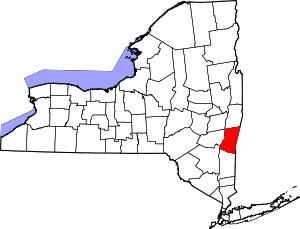Hudson, New York
| Hudson, New York | |
|---|---|
| City | |
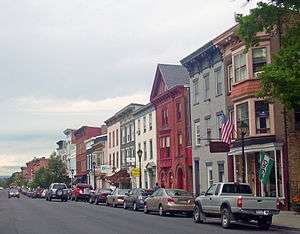 Warren Street in Hudson | |
| Etymology: From Henry Hudson | |
| Nickname(s): The Friendly City | |
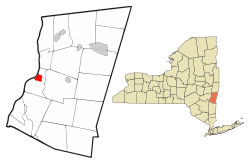 Location of Hudson, New York | |
.svg.png) Location of New York in the United States | |
| Coordinates: 42°15′0″N 73°47′23″W / 42.25000°N 73.78972°WCoordinates: 42°15′0″N 73°47′23″W / 42.25000°N 73.78972°W | |
| Country | United States |
| State | New York |
| County | Columbia |
| Founded | Incorporated |
| Government | |
| • Mayor |
Rick Rector (D) |
| Area[1] | |
| • Total | 2.33 sq mi (6.03 km2) |
| • Land | 2.16 sq mi (5.59 km2) |
| • Water | 0.17 sq mi (0.45 km2) |
| Elevation | 100 ft (30 m) |
| Highest elevation | 420 ft (130 m) |
| Population (2010) | |
| • Total | 6,713 |
| • Estimate (2016)[2] | 6,404 |
| • Density | 2,967.56/sq mi (1,145.86/km2) |
| Time zone | UTC-5 (Eastern (EST)) |
| • Summer (DST) | UTC-4 (EDT) |
| ZIP Code | 12534 |
| Area code(s) | 518 Exchanges:671,822,828 |
| FIPS code | 36-021-35969 |
| FIPS code | 36-35969 |
| GNIS feature ID | 0953386 |
| Wikimedia Commons | Hudson, New York |
| Website |
www |
Hudson is a city located along the west border of Columbia County, New York, United States. As of the 2010 census it had a population of 6,713,[3] the second-largest in the county, following the nearby town of Kinderhook. Located on the east side of the Hudson River and 120 miles from the Atlantic Ocean, it was named for the river and its namesake explorer Henry Hudson.[4]
Hudson is the county seat of Columbia County. Hudson is sister city with Pallisa, Uganda.
Geography
According to the United States Census Bureau, the city has a total area of 2.3 square miles (6.0 km2). 2.2 square miles (5.6 km2) of it is land and 0.15 square miles (0.4 km2), or 7.38%, is water.[3]
Hudson is located 120 miles from New York Harbor, at the head of navigation on the Hudson River, on what originally was a spit of land jutting into the Hudson River between the South Bay and North Bay. Both bays have been largely filled in. Across the Hudson River lies the town of Athens in Greene County, New York; a ferry connected the two municipalities during much of the 19th century. Between them lies Middle Ground Flats, a former sandbar that grew due to both natural silting and also from dumping the spoils of dredging; today it is inhabited by deer and a few occupants of quasi-legal summer shanties. The Town of Greenport borders the other three sides of the city.
Demographics
| Historical population | |||
|---|---|---|---|
| Census | Pop. | %± | |
| 1790 | 2,584 | — | |
| 1800 | 3,664 | 41.8% | |
| 1810 | 4,048 | 10.5% | |
| 1820 | 5,310 | 31.2% | |
| 1830 | 5,392 | 1.5% | |
| 1840 | 5,672 | 5.2% | |
| 1850 | 6,286 | 10.8% | |
| 1860 | 7,187 | 14.3% | |
| 1870 | 8,615 | 19.9% | |
| 1880 | 8,670 | 0.6% | |
| 1890 | 9,970 | 15.0% | |
| 1900 | 9,528 | −4.4% | |
| 1910 | 11,417 | 19.8% | |
| 1920 | 11,745 | 2.9% | |
| 1930 | 12,337 | 5.0% | |
| 1940 | 11,517 | −6.6% | |
| 1950 | 11,629 | 1.0% | |
| 1960 | 11,075 | −4.8% | |
| 1970 | 8,940 | −19.3% | |
| 1980 | 7,986 | −10.7% | |
| 1990 | 8,034 | 0.6% | |
| 2000 | 7,524 | −6.3% | |
| 2010 | 6,713 | −10.8% | |
| Est. 2016 | 6,404 | [2] | −4.6% |
| U.S. Decennial Census[5] | |||
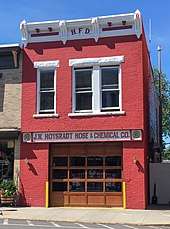
As of the census[6] of 2010, there were 6,713 people, 2,766 households, and 1,368 families residing in the city. The population was estimated at 6,648 in 2013. These numbers include the approximately 360 residents of the local Hudson Correctional Facility.
Population declines since the late 20th century may be attributable to demographic trends in which retirees, young couples, childless couples, singles, and weekenders have been gradually replacing larger families in the city. They have converted apartment buildings to single-family homes, and the number of unoccupied homes and rate of tax delinquency have declined.
The population density was 3,110.8 inhabitants per square mile (1,201.8/km2). The racial makeup of the city was 59.0% (55.5% Non-Hispanic) White, 25.0% African American, 0.4% Native American, 7.1% Asian, 0.1% Pacific Islander,and 5.2% from two or more races. Hispanic or Latino of any race were 8.2% of the population.
There were 2,766 households out of which 25.2% had children under the age of 18 living with them, 24.6% were married couples living together, 19.4% had a female householder with no husband present, and 50.5% were non-families. 40.9% of all households were made up of individuals and 13.6% had someone living alone who was 65 years of age or older. The average household size was 2.24 and the average family size was 3.09.
In the city, the population was spread out with 22.5% under the age of 18, 9.8% from 18 to 24, 27.3% from 25 to 44, 27.0% from 45 to 64, and 13.5% who were 65 years of age or older. The median age was 37.5 years. For every 100 females, there were 106.7 males. For every 100 females age 18 and over, there were 105.6 males.
The median income for a household in the city was $35,117, and the median income for a family was $37,400. Males had a median income of $26,274 versus $22,598 for females. The per capita income for the city was $22,353. About 23.0% of families and 23.2% of the population were below the poverty line, including 31.8% of those under age 18 and 19.1% of those age 65 or over.
History
The native Mahican people had occupied this territory for hundreds of years before European encounter, preceded by thousands of years of indigenous cultures. Dutch colonists began to settle here in the 17th century, calling it "Claverack Landing", having other settlements in Manhattan and at Albany, downriver and up, respectively. In 1662 some Dutch bought this area of land from the Mahican. It was originally part of the Town of Claverack.
After the English took over New Netherland, this area was settled largely by Quaker New England whalers and merchants hailing primarily from the islands of Nantucket and Martha's Vineyard in Massachusetts, and Providence, Rhode Island. They capitalized on Hudson being at the head of navigation on the Hudson River and developed it as a busy port. Hudson was chartered as a city in 1785, soon after the United States achieved independence from Great Britain. The self-described "Proprietors" laid out a city grid. Hudson grew rapidly as an active port and came within one vote of being named by the state legislature as the capital of New York state, losing to Albany, an historic center of trade from the 17th century.[7]
Hudson grew rapidly and by 1790 was the 24th-largest city in the United States.[8] In 1820, it had a population of 5310, and ranked as the fourth-largest city in New York, after New York City, Albany and Brooklyn.[9] Construction of the Erie Canal in 1824 drew development west in the state, stimulating development of cities related to Great Lakes trade, such as Rochester and Buffalo, although the Hudson River continued to be important to commerce.
During the 19th century, considerable industry was developed in Hudson, and the city became known as a factory town. It attracted new waves of immigrants and migrants to industrial jobs. Wealthy factory owners and merchants built fine houses in the Victorian period. Hudson obtained a new charter in 1895. It reached its peak of population in 1930, with 12,337 residents.
In 1935, to celebrate the sesquicentennial of the city, the United States Mint issued the Hudson Half Dollar. The coin is one of the most rare ever minted by the United States Government, with only 10,008 coins struck. On the front of the coin is an image of Henry Hudson's ship the Half Moon, and on the reverse is the seal of the city. Local legend has it that coin was minted on the direct order of President Franklin Delano Roosevelt to thank the Hudson City Democratic Committee for being the first to endorse him for state senator and governor.
In the late 19th and first half of the 20th century, Hudson became notorious as a center of vice, especially gambling and prostitution.[10] (The former Diamond Street is today Columbia Street.) At the peak of the vice industry, Hudson boasted more than 50 bars. These rackets were mostly broken up in 1951, after surprise raids of Hudson brothels by New York state troopers under orders from Governor Thomas E. Dewey netted several local policemen, among other customers.[10]
Land use controversy
From late 1998 until spring 2005, a land use conflict took place when St. Lawrence Cement (SLC), a subsidiary of Swiss multinational Holderbank (since renamed Holcim), then one of the world's largest cement companies, proposed to build a cement-manufacturing plant. The massive coal-fired plant project would have occupied more than 1,800 acres (7.3 km2) in the city of Hudson and the town of Greenport. Supporters cited the project for jobs and stimulating other growth. Sustained grassroots opposition to the project was led by business owner Peter Jung[11] and journalist Sam Pratt,[12][13] co-founders of Friends of Hudson (FOH).[14] Opponents argued the proposed project violated state environmental regulations and would adversely affect the river, shoreline, and related habitats.
The controversy gained national attention from news outlets such as CNN and The New York Times, as well as media outlets in Canada and Switzerland. The project was withdrawn after New York Secretary of State Randy Daniels determined that the company's plans were inconsistent with New York State's 24 coastal policies.[15] Opponents of the cement project described the ruling as "a colossal relief" and supporters, including the Business Council of New York State, denounced it as "flawed in its logic".[16] Nearly 14,000 public comments were received by the State's Division of Coastal Resources (87% of them opposed to the project), a record for that agency.[17]
Economy
After a steep economic decline in the 1960s and '70s, following the loss of jobs due to restructuring in the manufacturing sector, the city has undergone a significant revival. The economy has shifted to one based on tourism, services and related retail.
Attracted by its quality architecture, a group of antiques dealers opened shops on the city's main thoroughfare, Warren Street, in the mid-1980s. Among these were the Hudson Antiques Center, founded by Alain Pioton, and the English Antiques Center. In the early 21st century, the city has nearly seventy shops now, represented by the Hudson Antiques Dealers Association (HADA). The business revival stimulated tourism and attracted residents, some taking second homes in the city. It has become known for its active arts scene, restaurants, art galleries and nightlife, in addition to the antique shops.[18]
LGBTQ life
In the early 21st century, Hudson has become a destination for LGBTQ people. Many have opened new businesses, moving here from larger urban areas, and have led the restoration of many of the city's historic houses. In 2010, Hudson High School made national history when openly gay seniors, Timothy Howard and Charlie Ferrusi, won prom king and queen. During the same year, Hudson hosted its first gay pride parade, which was attended by several hundred people.[19]
National Register of Historic Properties listings
With hundreds of properties listed or eligible to be listed in the State and National registers of historic places, Hudson has been called the "finest dictionary of American architecture in New York State".[20] The vast majority of properties listed within the Hudson Historic District are considered to be contributing, attesting to their quality.[20]
These properties include the Dr. Oliver Bronson House and Estate, Dr. Oliver Bronson House and Stables, Henry A. and Evanlina Dubois House, Cornelius H. Evans House, Front Street-Parade Hill-Lower Warren Street Historic District, Houses at 37–47 North Fifth Street, Hudson Almshouse, Hudson Historic District, Hudson/Athens Lighthouse, Rossman-Prospect Avenue Historic District, United States Post Office, William Henry Ludlow House, Elisha Williams House, Oliver Wiswall House, and Van Salsbergen House.[21]
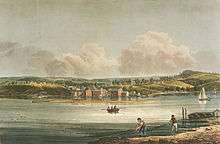 Artist's rendering of fishermen on the Athens side of the Hudson, with view of City of Hudson waterfront (date unknown)
Artist's rendering of fishermen on the Athens side of the Hudson, with view of City of Hudson waterfront (date unknown) Engraved view of the city (date, artist unknown)
Engraved view of the city (date, artist unknown)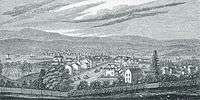 South Western View of Hudson City N.Y. from Academy Hill, or Prospect Hill (1837) by W.H. Bartlett
South Western View of Hudson City N.Y. from Academy Hill, or Prospect Hill (1837) by W.H. Bartlett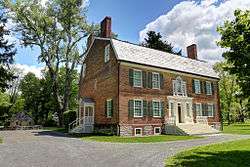 The 1786 William Henry Ludlow house
The 1786 William Henry Ludlow house
Attractions
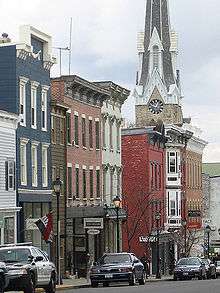
Hudson is home to the Firemen's Association of the State of New York (FASNY) Museum of Firefighting, one of the largest fire service-centered museums in the world. It is on the grounds of the FASNY Firemen's home, the first nursing home for firemen in the country.
The Hudson Music Festival is an annual event established in 2011 and is New York's largest free music festival. The fourth annual Hudson Music Festival took place August 8, 9 & 10, 2014 and showcased 100 acts.[22][23][24]
Hudson Hall, an arts venue and organization, is located on Warren Street in the center of the city. It is New York's oldest operating theater.[25]
Time & Space Limited, a not-for-profit arts organization serves the City of Hudson and the Hudson River Valley Region. It shows a wide selection of independent movies.[26]
A farmers market takes place on Saturdays, offering a variety of fresh organic products from the Hudson Valley area. The market is conducted outdoors in the warm season and indoor in the wintertime.
Many local restaurants purchase fresh meat, eggs, herbs, and produce from the nearby Letterbox Farm Collective.[27]
Government

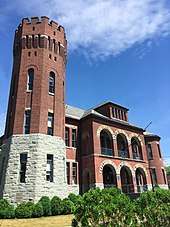
The city has a mayor-council form of elected government. Since the 1990s, five mayors have served: William Allen, Dolly Allen, Richard Scalera, Kenneth Cranna, Richard Tracy, William Hallenbeck, Tiffany Martin Hamilton. This period has been marked by unusual levels of friction between elected officials and residents, as the demographics and economics of the city have shifted. The Common Council consists of ten members elected from five districts, and a Council President elected citywide, as is the Treasurer.
Representation in other media
Several movies and television shows have been filmed in Hudson:
- Odds Against Tomorrow (1959), starring Harry Belafonte
- Ironweed, starring Jack Nicholson and Meryl Streep
- The PBS documentary Two Square Miles, directed by Barbara Ettinger, is about Hudson.[28]
- Our Town: Hudson, WHMT Aired: 2011[29]
- Hudson is referenced throughout the series Gossip Girl as the home of Alison Humphrey and later Jenny Humphrey
Local news sources
Notable people
- Marina Abramović, performance artist
- Robert Adams, American sailor and explorer
- John Ashbery, New York State poet laureate[30]
- Melissa Auf der Maur, musician (The Smashing Pumpkins, Hole) and owner of Basilica Hudson, an arts and performance venue[31][32]
- Rashad Barksdale, New York Giants cornerback
- J. D. Cannon, actor[33]
- Nicolas Carone, artist
- John Corapi, born and grew up in Hudson, accountant who turned to religion and became a Catholic priest, whistleblower in false claims suit in California, spoke about Catholicism on radio and TV; suspended from ministry by his order, he resigned
- Lynn Davis, photographer
- Tom Davis, comedian
- Alice Mary Dowd (1855–1943), educator, author
- George C. Ewing, politician, and founder of Holyoke, Massachusetts[34]
- Nancy Fuller, host of Food Network's Farmhouse Rules[35]
- Sanford Robinson Gifford, was born here in 1823 and grew up here; an artist, he became a member of the second generation of the Hudson River School landscape painters. Following his death on August 29, 1880, he was buried in Hudson's Cedar Park Cemetery.
- Philip Glass, composer
- Joshua Lee, US congressman
- Tyler Lydon, basketball player, first-round selection in 2017 NBA draft
- Sam J. Miller, science fiction author
- Alex MacKinnon, darts player
- Meshell Ndegeocello, musician[36]
- Benjamin Moore Norman, author and book dealer
- Dawn Langley Simmons, author and famous hermaphrodite (Simmons lived quietly in Hudson during the 1980s while writing her biography of Margaret Rutherford)
- Tommy Stinson, musician[37]
- Bob Trowbridge, former Major League Baseball pitcher
- Chris Urbanowicz, musician
- Martin Van Buren, future US President, set up his first law office in Hudson.
- William Jenkins Worth, was born on Union Street in Hudson and grew up here. He entered the military and served as a general during the Mexican–American War. Worth Avenue in Hudson is named after him, as is Fort Worth, Texas.
- Rupert Wyatt {film maker)
Transportation
Amtrak, the national passenger rail system, provides service to Hudson via the Hudson station.
Columbia County Public Transportation provides local service and commuter service to Albany.[38]
References and notes
- ↑ "2016 U.S. Gazetteer Files". United States Census Bureau. Retrieved Jul 4, 2017.
- 1 2 "Population and Housing Unit Estimates". Retrieved June 9, 2017.
- 1 2 "Geographic Identifiers: 2010 Demographic Profile Data (G001): Hudson city, New York". U.S. Census Bureau, American Factfinder. Retrieved December 8, 2014.
- ↑ "Find a County". National Association of Counties. Archived from the original on 2011-05-31. Retrieved 2011-06-07.
- ↑ "Census of Population and Housing". Census.gov. Archived from the original on May 12, 2015. Retrieved June 4, 2015.
- ↑ "American FactFinder". United States Census Bureau. Retrieved 2008-01-31.
- ↑ Margaret B. Schram, Hudson's Merchants and Whalers: The Rise and Fall of a River Port, 1783-1850, Black Dome Printing, 2004
- ↑
- ↑ [https://www.census.gov/population/documentation/twps0027/tab05.txt]
- 1 2 Bruce Edward Hall, Diamond Street: The Story of the Little Town with the Big Red Light District, Black Dome Printing, 1994
- ↑ Public Broadcasting System (PBS), from Two Square Miles documentary: "Jung co-founded Friends of Hudson and served as president of the organization throughout most of its six-year battle with St. Lawrence Cement."
- ↑ Public Broadcasting System (PBS): "Pratt is the devoted co-founder and executive director of Friends of Hudson, the grassroots organization that has helped score a series of against-the-odds environmental and political victories in the Hudson Valley, including the fight against the St. Lawrence Cement plant proposal."
- ↑ The Independent newspaper (Hillsdale, NY): "Opposition leader Sam Pratt, executive director of Friends of Hudson, welcomed the decision." NOTE: Newspaper is now defunct, but this article is archived at StopThePlant.com
- ↑ Detailed chronology of cement plant controversy, Stop the Plant website
- ↑ The Business Review (April 25, 2005). "Secretary of state rejects St. Lawrence Cement plant on Hudson". American City Business Journals. Retrieved 2011-10-30.
- ↑ BCNYS (April 21, 2005). "Council Sharply Criticizes the Pataki Administration's Decision on the Proposed St. Lawrence Cement Plant". The Business Council of New York State. Retrieved 2011-10-30.
- ↑ Friends of Hudson (March 28, 2005). "87% Of Commenters Oppose Cement Plant". Friends Of Hudson. Retrieved 2011-10-30.
- ↑ Smith, Gene. "America on the Hudson", American Heritage, April/May 2004.
- ↑ School's Acceptance a crowning moment, Times Union, 2010
- 1 2 Byrne Fone, Historic Hudson: An Architectural Portrait, Black Dome Press, 2005
- ↑ National Park Service (2010-07-09). "National Register Information System". National Register of Historic Places. National Park Service.
- ↑ http://www.hudsonmusicfest.com/
- ↑ "Archived copy". Archived from the original on 2014-12-16. Retrieved 2014-09-28. ]
- ↑
- ↑ https://www.timesunion.com/upstate/article/Hudson-s-evolution-from-whalers-to-weekenders-12938406.php
- ↑ Smith, Dinitia (Jan 18, 2001). "Art From a River;s Past (and Its Present)". New York Times. Retrieved September 25, 2017.
- ↑ "Restaurants". Letterbox Farm Collective. Retrieved 2015-10-13.
- ↑ Two Square Miles
- ↑
- ↑ John Ashbery
- ↑ Amy Griffinl. "Basilica Hudson a new temple of contemporary art", Times Union, July 24, 2011. Retrieved August 9, 2013.
- ↑ Peter Aaron. "Melissa Auf der Maur: Girl from the North Country", Chronogram, March 1, 2011. Retrieved August 9, 2013.
- ↑ "J.D. Cannon, 83, Dies; Actor on McCloud", nytimes.com; accessed March 13, 2016.
- ↑ Cutter, William Richard; Adams, William Frederick (1951). Genealogical and Personal Memoirs Relating to the Families of the State of Massachusetts. II. New York: Lewis Historical Publishing Company. p. 894. OCLC 1547995.
- ↑ Clayton, Adam (November 13, 2013). "Ginsberg's owner brings her 'Farmhouse Rules' to Food Network - Columbia-Greene Media: News". Chatham Courier. Retrieved May 13, 2014.
- ↑ Nieman Culpepper, Carrie (September 5, 2010). "Hudson, N.Y.: Where Bands Feel at Home". The New York Times. Retrieved 2011-03-19.
- ↑ Waldman, Scott (6 January 2012). "Hudson grows as a musician-friendly town". Times Union. Retrieved 2 October 2013.
- ↑ Columbia County Public Transit
External links
| Wikivoyage has a travel guide for Hudson (New York). |
| Wikimedia Commons has media related to Hudson, New York. |
| Wikisource has the text of an Encyclopaedia Britannica (9th ed.) article about Hudson, New York. |
